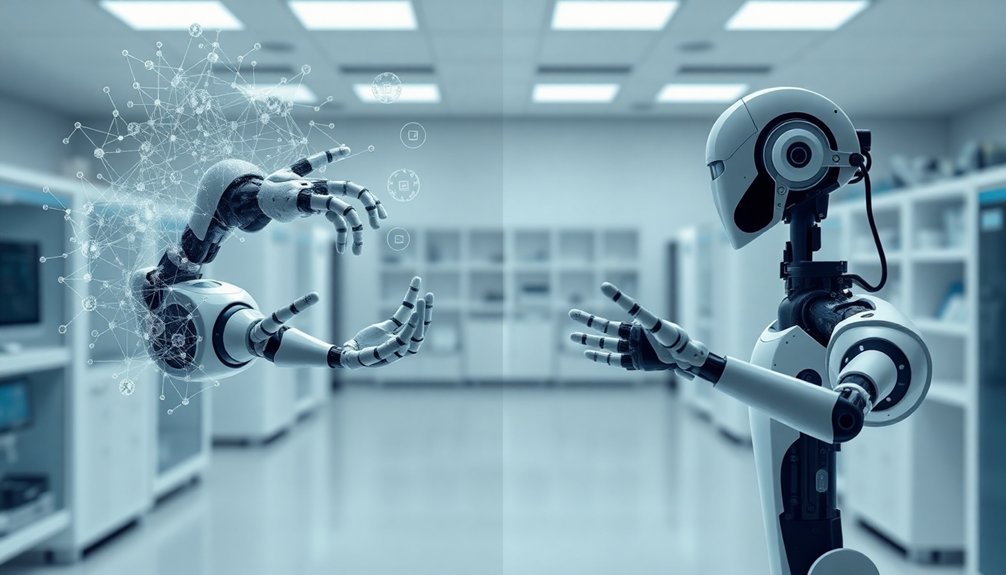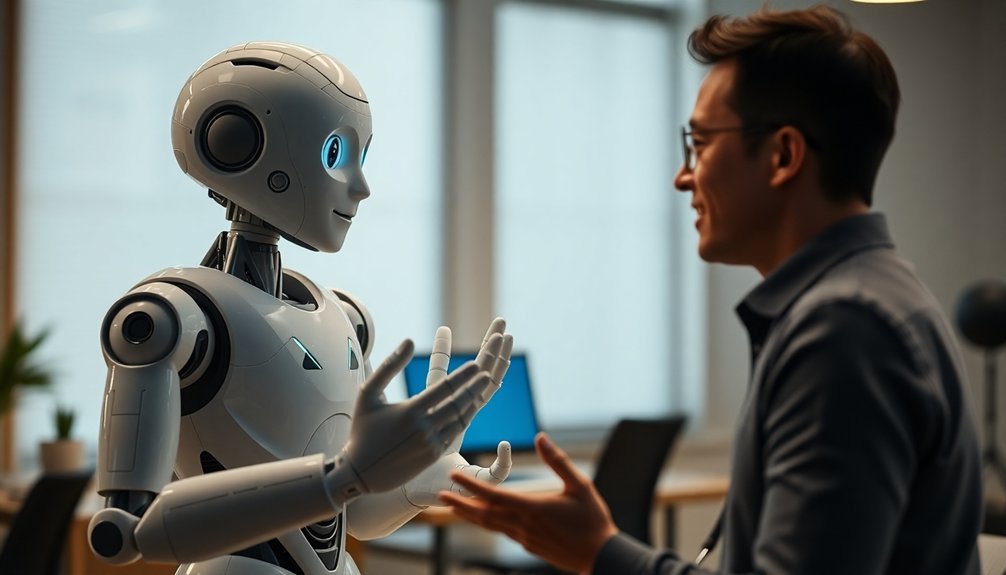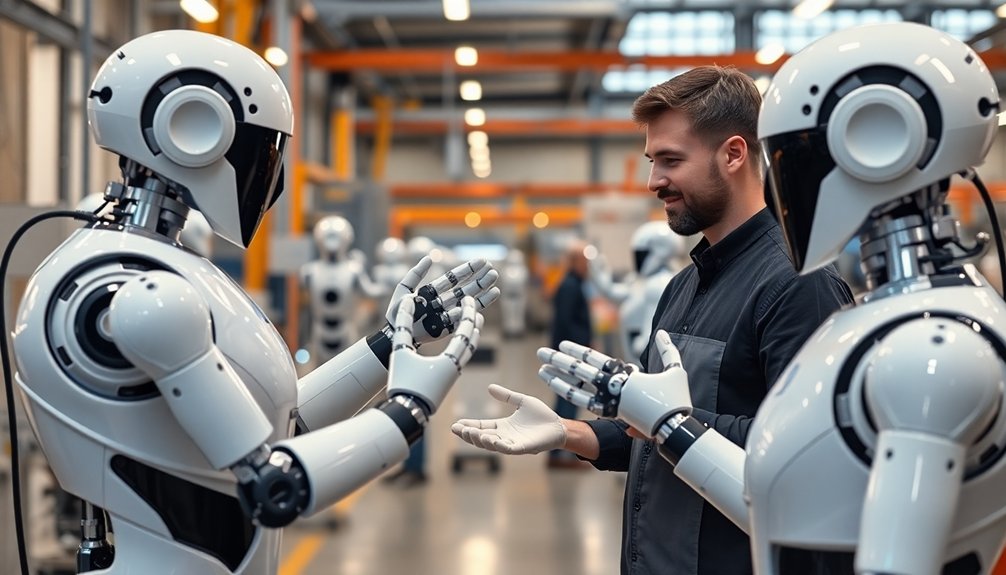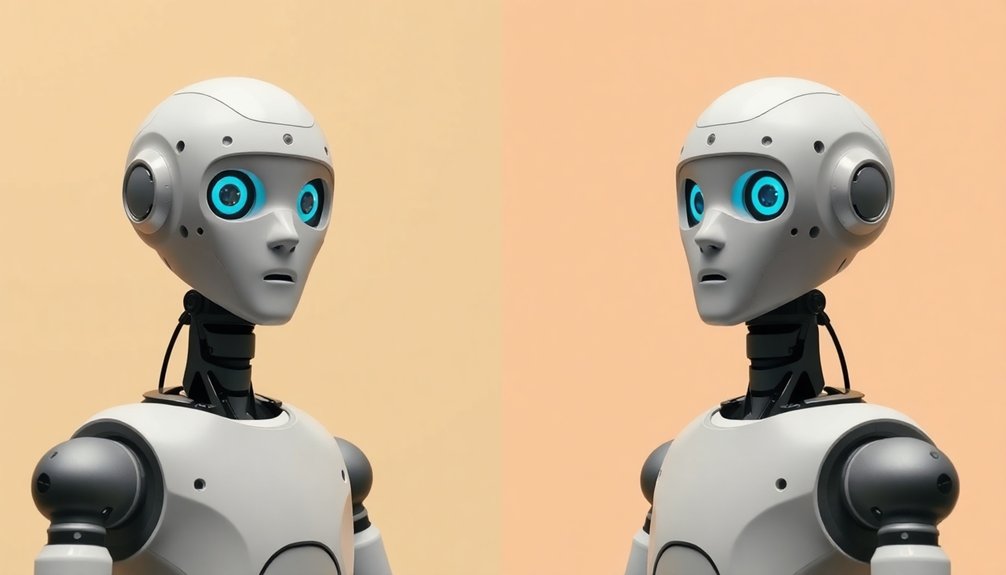Language models are turning robots from clunky machines into your new best conversational buddies. They’re breaking down communication walls, letting robots understand your weird instructions and emotional nuances like never before. Imagine a robot that gets your context, adapts on the fly, and responds with human-like precision. Computer vision and AI are merging to create intelligent companions that aren’t just tools, but partners. Curious about the robot revolution?
The Evolution of Large Language Models in Robotics

While the world was busy scrolling through memes and debating smartphone features, something quietly revolutionary was brewing in the labs of AI researchers: Large Language Models were about to transform how robots understand and interact with humans.
LLMs like GPT-1, GPT-2, and GPT-3 weren’t just fancy text generators—they were rewiring the entire landscape of human-robot interaction. Natural language processing suddenly jumped from clunky scripts to fluid conversations.
Imagine robots that can understand context, reason through complex scenarios, and respond naturally—without requiring developers to pre-program every single interaction. These models brought conversational autonomy to robotics, enabling machines to interpret nuanced instructions and adapt in real-time.
Machines evolving beyond rigid scripts: robots learning to converse, reason, and adapt with human-like fluidity.
Who knew algorithms could make robots sound less like stilted machines and more like intelligent conversationalists?
Breaking Down Communication Barriers
You’re probably wondering how robots went from clunky command-line machines to conversational companions that actually understand what you want.
Large language models have cracked the code of human-robot communication, letting you talk to machines like they’re smart friends who get your context and nuance.
Advanced Language Understanding
Because communication between humans and robots has long been a clunky, frustrating experience, advanced language understanding represents a quantum leap in how we’ll interact with machines.
Imagine robots that don’t just hear your words, but truly get what you mean. Natural Language Processing (NLP) is making this possible, transforming human-robot interaction from robotic scripts to fluid, intuitive communication.
Seamless Robot Communication
Natural language understanding means robots can now interpret your requests with startling precision. Advanced acoustic models transform intricate human speech into precise robotic commands. Want a robot to grab a coffee or help with complex tasks? They’ll get it—no programming degree required. Large language models make human-robot interaction feel less like talking to a glorified calculator and more like chatting with a helpful assistant. Conversational capabilities are making robots accessible to the general public, turning sci-fi fantasies into everyday reality. Who’s awkward now?
Natural Interaction Paradigms
While traditional robot interactions felt like decoding a foreign language, modern Large Language Models (LLMs) are shattering those communication barriers faster than you can say “artificial intelligence.”
Imagine robots that don’t just hear your words, but truly understand the nuanced subtext behind them—context, emotion, intent, all decoded in milliseconds.
LLMs revolutionize how we interact with robots by enabling natural communication that feels less like programming and more like conversation.
These intelligent systems let robots understand complex requests, adapt to context, and respond with remarkable human-like precision.
No more robotic, scripted responses—now robots can engage in fluid dialogue, interpreting your needs dynamically.
They’re not just machines anymore; they’re conversation partners who actually get what you’re saying.
Neural networks enable robots to develop sophisticated motor skills and adaptive behaviors by transforming raw sensory data into intelligent, context-aware interactions.
Enhancing Contextual Understanding
Imagine a robot that doesn’t just hear your words, but truly gets what you mean.
These contextual understanding wizards can now adapt responses in real-time, making interactions feel less robotic and more like chatting with a weirdly intelligent friend.
Zero-shot planning means they can tackle new tasks without breaking a sweat—or a circuit.
The result? An improved user experience that turns clunky machine interactions into seamless, almost magical conversations.
From Scripted Responses to Natural Conversations

You’ve probably suffered through enough robotic, awkward conversations with chatbots to know how painful scripted responses can be.
Language models are changing the game by giving robots the ability to understand context, nuance, and human communication in ways that feel surprisingly natural and spontaneous.
Imagine a robot that doesn’t just spit out pre-programmed lines, but actually listens, adapts, and responds like a quick-witted friend who’s been paying attention.
Breaking Communication Barriers
As language models revolutionize robotic communication, we’re witnessing the death of clunky, pre-programmed robot dialogue.
Imagine chatting with a machine that actually gets you—no more awkward, scripted responses that sound like they’ve been pulled from a 1990s customer service manual.
LLMs are breaking down communication barriers, transforming how we interact with robots from rigid command-response interactions to fluid, natural conversations.
These smart systems let robots understand context, nuance, and even humor.
Want a robot assistant that doesn’t sound like a robotic parrot? Language models are your ticket.
They’re teaching machines to parse human intent, respond dynamically, and engage in conversations that feel surprisingly human.
The future isn’t about robots talking at you—it’s about robots talking with you.
Fluid Robot Dialogue
Could robots finally stop sounding like broken answering machines? LLMs are transforming human-robot interaction from stiff, programmed exchanges to fluid conversations that actually feel human. With natural language processing, robots are leveling up their communication skills:
- Interpreting subtle context and nuance
- Responding dynamically without pre-scripted answers
- Understanding complex user instructions
- Adapting conversation in real-time
Imagine a robot that doesn’t just repeat memorized phrases but genuinely understands you. These language models are revolutionizing robot skill development, turning clunky machines into intelligent conversationalists.
No more robotic monotone or blank stares—we’re talking about machines that can read between the lines, catch your drift, and engage like a witty friend. The future of human-robot interaction isn’t just about understanding words; it’s about understanding intention, emotion, and the beautiful complexity of human communication.
Computer Vision and Language Processing Synergy
When robots start seeing and talking like they’ve got a brain behind those sensors, something magical happens.
Computer vision and language processing join forces, turning robots from clunky machines into intelligent companions. Large Language Models (LLMs) supercharge this transformation, helping robots understand visual inputs and human instructions with crazy precision.
Imagine telling a robot to “grab that blue mug on the messy table” and watching it actually comprehend your request. Depth perception techniques enable robots to build sophisticated 3D environmental understanding, enhancing their ability to navigate and interact with complex spaces.
Multimodal sensor data means these machines aren’t just following rigid commands anymore—they’re interpreting context, adapting to environments, and learning on the fly.
The synergy between visual perception and language skills is rewriting the rules of human-robot interaction. Who knew machines could become this smart, this quick, this intuitive?
Real-World Applications Across Industries

You’ve probably wondered how robots are transforming industries beyond sci-fi fantasies, and the answer lies in the magic of language models connecting machines to human communication.
In healthcare, these smart robots can now interpret patient needs and assist medical staff, while in manufacturing, they’re understanding complex instructions and executing tasks with precision that makes traditional automation look like child’s play.
Imagine a world where a robot can’t only lift heavy machinery but also understand the nuanced context of a worker’s verbal command — that’s the real-world revolution happening right now. Moreover, deep reinforcement learning enables robots to adapt and improve their performance across diverse industrial environments, creating increasingly intelligent and responsive automation systems.
Healthcare Robotic Assistance
Because healthcare is about to get a serious robot upgrade, large language models are transforming how medical robots interact with patients and professionals. LLMs are making healthcare robots way smarter than your average medical gadget. Robotic emotional intelligence derived from advanced language models addresses key concerns about genuine human-like interaction and empathy in technological caregiving.
Imagine robots that can:
- Decode complex medical jargon in milliseconds
- Provide empathetic patient communication
- Monitor health conditions with precision
- Offer emotional support during stressful medical moments
Robotic nurses equipped with these language models aren’t just machines anymore—they’re intelligent companions. They understand nuanced patient needs, translate medical complexity into digestible conversations, and reduce healthcare professional burnout.
Think of them as your tech-savvy medical sidekick, ready to make hospital interactions less intimidating and more human. Who knew robots could be this emotionally intelligent?
Welcome to the future of healthcare, where technology meets compassion head-on.
Manufacturing Intelligent Automation
| LLM Capability | Impact | Productivity Boost |
|---|---|---|
| Zero-Shot Learning | Task Adaptability | 35% Faster |
| Natural Language Processing | Communication | 40% Clearer |
| Intelligent Automation | Operational Flexibility | 50% Smoother |
These intelligent systems aren’t just replacing workers—they’re becoming collaborative partners. By understanding context and nuance, robots can now interpret subtle instructions, dramatically reducing downtime and ramping up manufacturing precision. Who said robots can’t be smart conversationalists? Reinforcement learning algorithms are revolutionizing how robots adapt and interact with human workers, creating a more seamless integration of technological capabilities in manufacturing environments.
Challenges in Human-Robot Interaction
Imagine trying to have a heart-to-heart chat with a robot that stares blankly back at you, missing every nuanced gesture and emotional cue. Current language models struggle to bridge the communication gap, leaving robots feeling more like awkward machines than intelligent companions. Neuromorphic computing algorithms are emerging as a potential solution to create more emotionally responsive robotic interactions.
The challenges in human-robot interaction are real, and they boil down to some critical limitations:
Breaking barriers in human-robot communication means confronting core technological limitations head-on.
- LLMs can’t naturally interpret subtle body language
- Robots lack genuine emotional responsiveness
- Non-verbal behaviors remain mechanical and unconvincing
- Human-like responses feel programmed, not spontaneous
These models are trying to interact with people, but they’re missing the secret sauce of genuine communication. It’s like teaching a calculator to write poetry — technically possible, but painfully robotic.
The future of human-robot interaction hinges on cracking this complex code of natural, intuitive exchange.
Zero-Shot Learning and Adaptive Capabilities

When robots break free from rigid, pre-programmed instructions, they start to look less like clunky machines and more like adaptable teammates. Neural networks transform these mechanical systems into sophisticated learners capable of complex decision-making. Zero-shot learning transforms robots into quick-thinking problem solvers that can tackle new tasks without endless training. By leveraging Large Language Models (LLMs), these mechanical companions understand natural language commands and adapt on the fly.
Imagine telling a robot to organize your messy garage, and it actually gets it right—without you spending hours programming every single step.
The magic happens through adaptive capabilities that let robots interpret context, understand nuanced instructions, and create user-friendly interactions.
Who wouldn’t want a smart assistant that learns faster than your average intern and doesn’t complain about overtime?
Ethical Considerations and Responsible AI
Because robots aren’t just fancy toasters anymore, we’ve got to get serious about the ethical minefield of AI interactions. Your future silicon companions come with some serious baggage:
- Potential bias reinforcement from training data
- Sneaky privacy invasions via data collection
- Opaque decision-making processes
- Potential for unintended discriminatory behaviors
Ethical considerations aren’t just academic exercises—they’re critical safeguards. Responsible AI demands transparency, where robots can explain their choices like a transparent teammate.
AI ethics aren’t theoretical—they’re mission-critical guardrails demanding radical transparency and algorithmic accountability.
Data privacy isn’t negotiable; it’s a fundamental right in our increasingly connected world. You’ll want continuous monitoring to catch algorithmic slip-ups before they become societal problems.
Think of these AI guardians like sophisticated diplomatic translators: they need clear guidelines, cultural sensitivity, and an unwavering commitment to doing no harm.
The future’s watching—and it expects better. Algorithmic prejudice represents a critical challenge in ensuring AI systems don’t perpetuate systemic inequalities inherent in historical training data.
Future Trajectory of Intelligent Robotic Systems

As intelligent robotic systems evolve from clunky lab experiments to sleek, conversation-capable companions, we’re witnessing a technological revolution that’ll make your smartphone look like a rusty calculator. LLMs are turbocharging human-robot interactions, pushing intelligent machines beyond rigid programming into adaptive, emotionally nuanced territories. Humanoid robots like Figure 01 are pioneering this transformative journey by demonstrating unprecedented capabilities in emotional support and adaptive learning.
| Capability | Near Future | Long-Term Vision |
|---|---|---|
| Communication | Basic Dialog | Contextual Understanding |
| Decision Making | Structured | Zero-Shot Planning |
| Emotional Range | Limited | Complex Expressions |
| Input Processing | Uni-Modal | Multimodal |
| Interaction Style | Scripted | Fluid Conversation |
Imagine robots that don’t just listen but understand, responding with genuine emotional intelligence. Multimodal input means they’ll read your facial expressions, tone, and context—not just decode words. They’re becoming less machine, more partner. Isn’t that wild?
People Also Ask About Robots
Why Is Human-Robot Interaction Important?
You’ll find human-robot interaction essential because it enhances communication, improves task efficiency, and creates more intuitive experiences across healthcare, education, and service industries, ultimately making technology more accessible and user-friendly.
What Is the Large Language Model for Robotics?
Like a universal translator breaking language barriers, you’ll find large language models in robotics as sophisticated AI systems that enable robots to understand, interpret, and respond to human instructions with remarkable precision and adaptability.
What Are the Benefits of Human-Robot Collaboration?
You’ll boost productivity by partnering with robots that handle repetitive tasks, enhance workplace safety, and leverage AI communication. This collaboration lets you focus on creative problem-solving while robotic assistants efficiently execute complex operational demands.
How Is AI Impacting Human-Robot Interaction?
With AI-driven interactions increasing 65% annually, you’ll find language models revolutionizing robot communication. They’re enabling more intuitive, natural conversations, helping robots understand context, adapt to tasks, and interact seamlessly without complex programming.
Why This Matters in Robotics
Like travelers decoding an ancient map, language models are transforming robots from rigid automatons into nuanced companions. You’re witnessing a profound shift where machines don’t just understand commands, but grasp the subtle poetry of human communication. They’re learning to read between the lines, turning cold algorithms into empathetic interpreters of our complex social landscapes. The future isn’t about replacing humans, but bridging worlds through intelligent conversation.
